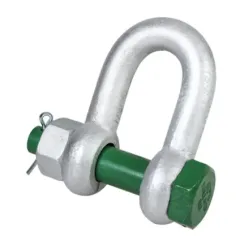Shackles: Understanding the Types and Uses for Industry
Bow shackle, round pin, and other types of shackles are commonly used as lifting or towing aids. But what exactly is a shackle? How many types of shackles are commonly used in this industry? Don't worry, this article will help you understand shackles better.
What is a Shackle?
A shackle, or seal, is a tool used to connect slings, whether wire rope, webbing, or chain, applied for lifting or towing purposes.
Types of Shackles
Shackles are classified based on two main criteria:
- Shape and type
- Type of lock
Let’s break down these classifications to avoid confusion:
Based on Shape and Type
There are two commonly used types of shackles based on their shape and type: D Shackle and Anchor/Bow Shackles.
- Anchor/Bow Shackles
The terms anchor shackles and bow shackles are used interchangeably and refer to a type of shackle with a larger, round “O” shaped bow. This larger bow shape allows these types of shackles to be side loaded or used in multiple sling-leg connections. Anchor shackles can be used for side pulling when you factor in the reduction to the WLL (Working Load Limit) based on the angle deviation from in-line (0°).
- Chain/D Shackles
Chain shackles, also referred to as D shackles, have a D-shaped bow that is narrower than anchor shackles. These shackles are designed and rated for in-line tension and should not be side loaded, as side loading can twist or bend the bow of the shackle. When using a chain shackle, the centerline of the load should always coincide with the centerline of the shackle.
Based on Type of Lock
There are three main types of shackles based on their locking mechanisms:
- Screw Pin: This type uses a pin with a screw but does not have a lock. The user tightens it until the threads are fully engaged. This type of shackle is typically used for non-permanent applications.
- Round Pin: Similar to the screw pin type but includes a lock at the end to prevent it from coming loose. Its function is also for non-permanent applications. However, in the field, screw pin types are more commonly used due to their ease of handling for non-permanent or repetitive installations.
- Bolt & Nut Type: This is one of the safest types of shackles, using a pin that resembles a bolt head. This type is commonly used in offshore projects and is generally intended for permanent applications.
Additionally, there are specialized types of shackles:
- Synthetic Sling Shackles: The bow of the shackle is widened to increase the efficiency of synthetic web or round slings. This design prevents pinching or bunching, which can damage the slings or reduce their rated capacity. They are available in screw pin or bolt type designs.
- Wide body shackles. Wide body shackles are used in conjunction with high capacity synthetic web slings, synthetic round slings, or wire rope slings. When using a shackle with wire rope, the shackle must be equal or greater than the wire rope diameter. The increased radius of the shackle bow provides:
- An increase in surface area for a better D/d ratio
- Improved service life of the sling
- Eliminates need for a thimble eye
- Prevents kinking and bunching of the sling around the bow
- Long reach shackles. Long reach shackles are ideal for use in construction applications where a longer reach is needed to attach to pick points. They can also be used as a bail for lifting thicker products.
Sheet Pile Shackles. Just what their name implies, they’re designed specifically for pulling sheet piling. These types of shackles are equipped with an easy opening pin that will not detach and become lost.
After understanding the different types of shackles discussed above, you can choose the type of shackle that best suits your needs. If you have any questions or are unsure about which shackle to choose, please contact us for assistance.
For further consultation about SpanSet Indonesia products and services, please contact us via email at [email protected] or WhatsApp
To find specification detail and prices of SpanSet Indonesia Products, please visit SpanSet Indonesia Marketplace on Tokopedia and Shopee.
